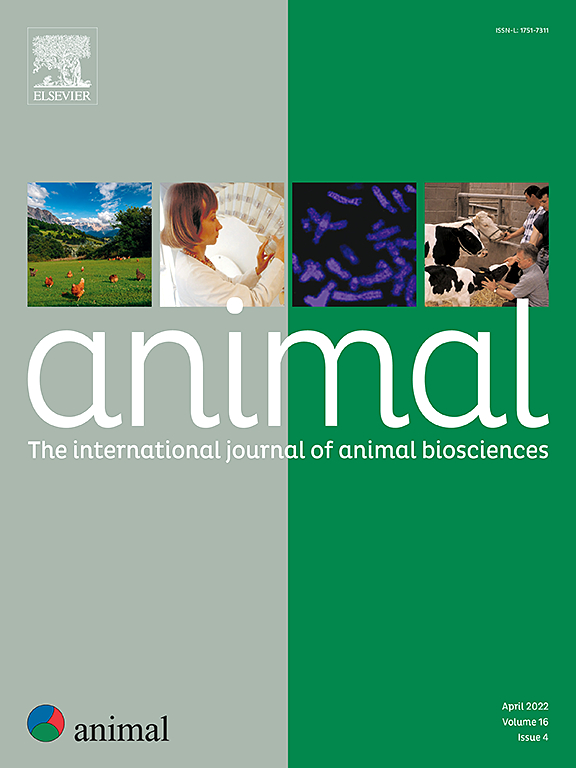慢生长鸡的运动活性:对血液和大腿肌肉抗氧化剂含量、脂肪酸分布、脂质氧化和代谢的影响
IF 4.2
2区 农林科学
Q1 AGRICULTURE, DAIRY & ANIMAL SCIENCE
引用次数: 0
摘要
鸡对粗放式饲养系统的适应取决于几个因素,包括基因型和个体动力活动的动机。在户外度过的时间与草和许多生物活性化合物(如工具、类胡萝卜素、多酚和多不饱和脂肪酸)的摄入量呈正相关。本研究探讨了室外饲养鸡的动力学活性、生物活性物质的摄入与机体代谢的关系。180只裸颈基因型雏鸡分别在室内(60只)和室外(120只,20只/圈,3个重复/试验组)饲养。从60日龄到80日龄,通过距离每个避难所5米的鸡门对室外动物进行监测。利用所得结果区分高活性鸡(OHA,过Gate 250次以上)和低活性鸡(OLA,过Gate不到40次)。在21 ~ 81日龄期间,对不同栏的采食量进行估算。屠宰时采集每组12只鸡的血液和肉标本,进行脂质(TBARS、硫代巴比妥酸活性物质)和蛋白质氧化、抗氧化剂、活性氧(ROS)、脂肪酸谱和类异前列腺素的评价。此外,解剖大腿肌肉以获得糖酵解(PIL)和氧化(PIFM)最多的肌肉。OHA鸡血液中α-生育三烯醇(0.40、0.45和0.79 pmol/mL)和TBARS(15.80、19.38和23.75 nmoL MDA/mL)含量较低,OLA鸡和室内鸡次之。鸡的运动对羰基和活性氧的变化趋势影响不显著。OHA导致n-3衍生物类异前列腺素水平较低(f3 -异前列腺素和f4 -神经前列腺素平均分别低1.65和2.33倍),低于OLA和室内鸡。肉类中抗氧化剂的变化趋势与血液中相似;然而,大腿的两块肌肉在几个特征上有所不同。尽管PFIM的抗氧化剂含量几乎是PIL的两倍,但TBARS和羰基含量也较高。OHA鸡的总n-6水平和n-6/n-3比值较高(室外和室内分别为16.96比9.63和7.31),而花生四烯酸、总n-3和n-3长链多不饱和脂肪酸水平较低。目前的研究强调,更活跃的动物比低觅食的动物摄入更多的草,影响主要抗氧化剂和脂肪酸的摄入水平。然而,这一更大的量并没有完全转移到血液或肌肉中,这可能是由于当代为了抗氧化和能量目的而大量消耗这些化合物。本文章由计算机程序翻译,如有差异,请以英文原文为准。
Kinetic activity in slow-growing chickens: effect on antioxidant content, fatty acids profile, lipid oxidation and metabolism of blood and thigh muscles
The adaptation of chickens to extensive rearing systems depends on several factors, including genotype, and individual motivation for kinetic activity. The time spent outdoors is positively associated with the intake of grass and many bioactive compounds (e.g., tocols, carotenoids, polyphenols and polyunsaturated fatty acids). In this study, the relationships among kinetic activity, intake of bioactive compounds and body metabolism in outdoor-reared chickens were investigated. One hundred eighty chicks of the Naked Neck genotype were reared indoors (60 birds) or in an outdoor range (120 birds, 20 chickens/pen, three replications/experimental group). The outdoor animals were monitored from 60 to 80 days of age through a ChickenGate placed 5 m from each shelter. The obtained results were used to discriminate high (OHA, crossing the Gate more than 250 times) and low (OLA, crossing the Gate less than 40 times) activity chickens. The grass intake in the different pens was estimated from 21 to 81 days of age. Blood and meat samples were collected at slaughtering in 12 chickens/group for lipid (TBARS, thiobarbituric acid reactive substances) and protein oxidation, antioxidants, reactive oxygen species (ROS), fatty acid profile and isoprostanoid evaluations. Furthermore, the thigh muscle was dissected to obtain the most glycolytic (PIL) and oxidative (PIFM) muscles. Blood showed lower levels of α-tocotrienol (0.40, 0.45 and 0.79 pmol/mL) and TBARS (15.80, 19.38 and 23.75 nmoL MDA/mL) in OHA chickens, followed by OLA and indoor chickens. The trends of carbonyls, and ROS were not significantly affected by the kinetic activity of chickens. OHA resulted in lower levels of n-3 derivative isoprostanoids (on average 1.65 and 2.33-fold lower values of F3-isoprostanes and F4-neuroprostanes, respectively), than OLA and indoor chickens. The trend of antioxidants in meat was similar to that in blood; however, the two muscles of the thigh differed in several traits. Despite the almost double antioxidant content of PFIM with respect to PIL, the TBARS and carbonyl levels were also higher. OHA chickens presented higher total n-6 levels and n-6/n-3 ratios (16.96 vs 9.63 and 7.31 in OLA and indoor), whereas arachidonic acid, total n-3 and n-3 long−chain polyunsaturated fatty acids levels were lower. The present study highlights that more active animals ingested more grass than low-foraging animals, affecting the intake levels of the main antioxidants and fatty acids. However, this greater amount was not entirely transferred into the blood or muscles, probably due to the contemporary greater consumption of these compounds for antioxidant and energetic purposes.
求助全文
通过发布文献求助,成功后即可免费获取论文全文。
去求助
来源期刊

Animal
农林科学-奶制品与动物科学
CiteScore
7.50
自引率
2.80%
发文量
246
审稿时长
3 months
期刊介绍:
Editorial board
animal attracts the best research in animal biology and animal systems from across the spectrum of the agricultural, biomedical, and environmental sciences. It is the central element in an exciting collaboration between the British Society of Animal Science (BSAS), Institut National de la Recherche Agronomique (INRA) and the European Federation of Animal Science (EAAP) and represents a merging of three scientific journals: Animal Science; Animal Research; Reproduction, Nutrition, Development. animal publishes original cutting-edge research, ''hot'' topics and horizon-scanning reviews on animal-related aspects of the life sciences at the molecular, cellular, organ, whole animal and production system levels. The main subject areas include: breeding and genetics; nutrition; physiology and functional biology of systems; behaviour, health and welfare; farming systems, environmental impact and climate change; product quality, human health and well-being. Animal models and papers dealing with the integration of research between these topics and their impact on the environment and people are particularly welcome.
 求助内容:
求助内容: 应助结果提醒方式:
应助结果提醒方式:


